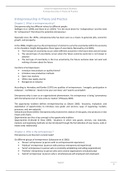Global Entrepreneurship & Business
Entrepreneurship in Theory & Practice
Entrepreneurship in Theory and Practice
Chapter 1. What is entrepreneurship?
Entrepreneurship has different values for different people.
Naffziger et al. (1994) and Shane et al. (2003): “It is the more desire for ‘independence’ and the need
for ‘achievement’ that drives the potential entrepreneur.
Especially since the 1970s, entrepreneurship has been seen as a means to generate jobs, economic
growth, and prosperity.
In the 1900s, Knights saw it as the entrepreneur’s function to carry the uncertainty within the economy
on his shoulders. Knight distinguishes three types of uncertainty (Sarasvathy et al 2005):
• The first type of uncertainty occurs when different outcomes in the future exist and are known
• The second type of uncertainty occurs when the future outcome exists but is not known in
advance
• The last type of uncertainty is the true uncertainty, the future outcome does not exist and
nothing is known about the future
Functions of entrepreneurs:
• Introduce new products or quality thereof
• Introduce new production methods
• Open new markets
• Utilize new supply sources
• Reorganize an industry
According to Hornaday and Bunker (1970) are qualities of entrepreneurs: ‘energetic participation in
endeavor’, ‘confidence’, ‘desire to be your own boss’ and ‘need to accomplish’.
Entrepreneurship is seen as an organizational phenomenon, the entrepreneur is being ‘synonymous
with the behavioral act of new venture creation’ (Pittaway 2003).
The opportunity tradition defines entrepreneurship as (Shane 2003): ‘discovery, evaluation, and
exploitation of opportunities to introduce new goods and services, ways of organizing, markets,
processes, and raw materials’.
Eckhardt and Shane (2003): Entrepreneurship involves the creation of new goals, new products or new
means-end-chains.
Opportunities are thus a key concept in the opportunity tradition.
Opportunities (Eckhardt & Shaw 2003): ‘situations in which new goods, services, raw materials,
markets, and organizing methods can be introduced through the formalization of new means, ends or
means-ends relationship’.
Chapter 2. Who is the entrepreneur?
Entrepreneurs are they born or/and made?
Six different groups of entrepreneurs (Ucbasaran et al 2001):
• ‘Novice’ entrepreneur (a person with no entrepreneurial experience)
• ‘Habitual’ entrepreneur (a person with previous entrepreneurial experience)
• ‘Serial’ entrepreneur (a person who is constantly establishing and selling organizations)
• ‘Portfolio’ entrepreneur (a person who owns several organizations simultaneously)
• ‘Hybrid’ entrepreneur (a person who is simultaneously self-employed and employed)
Tophof
1
, Global Entrepreneurship & Business
Entrepreneurship in Theory & Practice
• ‘Nascent’ entrepreneur (a person who is in the process of considering the establishment of a
new organization)
• ‘Intrapreneur ( a person acting entrepreneurially within an existing organization)
Entrepreneurs are born
The entrepreneurial activity comes from special individuals who have the:
• The desire to establish a private kingdom
• Will to conquer
• Joy of creating
Personal characteristics that are associated with entrepreneurs are (Shane 2010): ‘self-esteem,
‘novelty seeking, risk-taking propensity, disagreeableness, extraversion, emotional stability, openness
to experience and conscientiousness’.
Entrepreneurs are made
“The process of starting a business is not a single well-worn route marched along again and again by
identical entrepreneurs. New venture creation is a complex phenomenon: Entrepreneurs and their
firms vary widely’ (Gartner 1985).
The entrepreneurial process is seen as a result of an interaction between four components:
‘individual’, ‘organization’, ‘environment’ and ‘process’ (Gartner 1985).
Three cognitive characteristics that make entrepreneurs exploit opportunities (Shane 2003):
• Entrepreneurs are more optimistic in their impulse processing than others.
• Entrepreneurs have more willingness to generalize based on small samples than others.
• Entrepreneurs use their intuition more than others.
Fayolle’s individual process model, that all potential entrepreneurs run through.
Figure 1 Fayolle’s individual process model
Three variables of an intention (Ajzen 1991):
• Perceived behavioral control (how difficult or simple the individual perceives the project)
• Subjective norms (extent to social pressure to perform or not perform)
• Attitude towards the behavior (choose the entrepreneurial action rather than another action)
Tophof
2






